Subunit Interactions and cooperativity in the microtubule-severing AAA ATPase spastin
- PMID: 22637577
- PMCID: PMC3406712
- DOI: 10.1074/jbc.M111.291898
Subunit Interactions and cooperativity in the microtubule-severing AAA ATPase spastin
Abstract
Spastin is a hexameric ring AAA ATPase that severs microtubules. To see whether the ring complex funnels the energy of multiple ATP hydrolysis events to the site of mechanical action, we investigate here the cooperativity of spastin. Several lines of evidence indicate that interactions among two subunits dominate the cooperative behavior: (i) the ATPase activity shows a sigmoidal dependence on the ATP concentration; (ii) ATPγS displays a mixed-inhibition behavior for normal ATP turnover; and (iii) inactive mutant subunits inhibit the activity of spastin in a hyperbolic dependence, characteristic for two interacting species. A quantitative model based on neighbor interactions fits mutant titration experiments well, suggesting that each subunit is mainly influenced by one of its neighbors. These observations are relevant for patients suffering from SPG4-type hereditary spastic paraplegia and explain why single amino acid exchanges lead to a dominant negative phenotype. In severing assays, wild type spastin is even more sensitive toward the presence of inactive mutants than in enzymatic assays, suggesting a weak coupling of ATPase and severing activity.
Figures






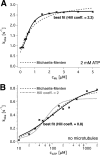
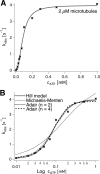
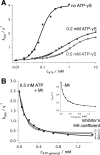

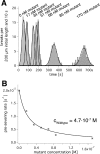
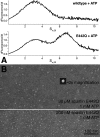
Similar articles
-
The nucleotide cycle of spastin correlates with its microtubule-binding properties.FEBS J. 2013 Aug;280(16):3868-77. doi: 10.1111/febs.12385. Epub 2013 Jul 12. FEBS J. 2013. PMID: 23745751
-
Structural basis of microtubule severing by the hereditary spastic paraplegia protein spastin.Nature. 2008 Jan 17;451(7176):363-7. doi: 10.1038/nature06482. Nature. 2008. PMID: 18202664 Free PMC article.
-
Linking axonal degeneration to microtubule remodeling by Spastin-mediated microtubule severing.J Cell Biol. 2005 Feb 14;168(4):599-606. doi: 10.1083/jcb.200409058. J Cell Biol. 2005. PMID: 15716377 Free PMC article.
-
Hereditary spastic paraplegia SPG4: what is known and not known about the disease.Brain. 2015 Sep;138(Pt 9):2471-84. doi: 10.1093/brain/awv178. Epub 2015 Jun 20. Brain. 2015. PMID: 26094131 Free PMC article. Review.
-
The AAA ATPase spastin links microtubule severing to membrane modelling.Biochim Biophys Acta. 2012 Jan;1823(1):192-7. doi: 10.1016/j.bbamcr.2011.08.010. Epub 2011 Aug 25. Biochim Biophys Acta. 2012. PMID: 21888932 Review.
Cited by
-
An allosteric network in spastin couples multiple activities required for microtubule severing.Nat Struct Mol Biol. 2019 Aug;26(8):671-678. doi: 10.1038/s41594-019-0257-3. Epub 2019 Jul 8. Nat Struct Mol Biol. 2019. PMID: 31285604 Free PMC article.
-
The molecular principles governing the activity and functional diversity of AAA+ proteins.Nat Rev Mol Cell Biol. 2020 Jan;21(1):43-58. doi: 10.1038/s41580-019-0183-6. Epub 2019 Nov 21. Nat Rev Mol Cell Biol. 2020. PMID: 31754261 Free PMC article. Review.
-
The Role of Spastin in Axon Biology.Front Cell Dev Biol. 2022 Jul 5;10:934522. doi: 10.3389/fcell.2022.934522. eCollection 2022. Front Cell Dev Biol. 2022. PMID: 35865632 Free PMC article. Review.
-
N-terminal phosphorylation of p60 katanin directly regulates microtubule severing.J Mol Biol. 2013 Jan 23;425(2):214-21. doi: 10.1016/j.jmb.2012.11.022. Epub 2012 Nov 23. J Mol Biol. 2013. PMID: 23178168 Free PMC article.
-
Graded Control of Microtubule Severing by Tubulin Glutamylation.Cell. 2016 Feb 25;164(5):911-21. doi: 10.1016/j.cell.2016.01.019. Epub 2016 Feb 11. Cell. 2016. PMID: 26875866 Free PMC article.
References
-
- Errico A., Claudiani P., D'Addio M., Rugarli E. I. (2004) Spastin interacts with the centrosomal protein NA14 and is enriched in the spindle pole, the midbody, and the distal axon. Hum. Mol. Genet. 13, 2121–2132 - PubMed
-
- Svenson I. K., Kloos M. T., Jacon A., Gallione C., Horton A. C., Pericak-Vance M. A., Ehlers M. D., Marchuk D. A. (2005) Subcellular localization of spastin. Implications for the pathogenesis of hereditary spastic paraplegia. Neurogenetics 6, 135–141 - PubMed
-
- Confalonieri F., Duguet M. (1995) A 200-amino acid ATPase module in search of a basic function. BioEssays 17, 639–650 - PubMed
Publication types
MeSH terms
Substances
LinkOut - more resources
Full Text Sources
Other Literature Sources
Molecular Biology Databases

